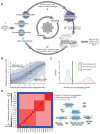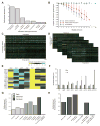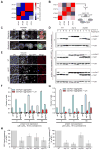Active Interaction Mapping Reveals the Hierarchical Organization of Autophagy
- PMID: 28132844
- PMCID: PMC5439305
- DOI: 10.1016/j.molcel.2016.12.024
Active Interaction Mapping Reveals the Hierarchical Organization of Autophagy
Abstract
We have developed a general progressive procedure, Active Interaction Mapping, to guide assembly of the hierarchy of functions encoding any biological system. Using this process, we assemble an ontology of functions comprising autophagy, a central recycling process implicated in numerous diseases. A first-generation model, built from existing gene networks in Saccharomyces, captures most known autophagy components in broad relation to vesicle transport, cell cycle, and stress response. Systematic analysis identifies synthetic-lethal interactions as most informative for further experiments; consequently, we saturate the model with 156,364 such measurements across autophagy-activating conditions. These targeted interactions provide more information about autophagy than all previous datasets, producing a second-generation ontology of 220 functions. Approximately half are previously unknown; we confirm roles for Gyp1 at the phagophore-assembly site, Atg24 in cargo engulfment, Atg26 in cytoplasm-to-vacuole targeting, and Ssd1, Did4, and others in selective and non-selective autophagy. The procedure and autophagy hierarchy are at http://atgo.ucsd.edu/.
Keywords: active interaction mapping; autophagy; hierarchical modeling; human; systems biology; yeast.
Copyright © 2017 Elsevier Inc. All rights reserved.
Figures







Similar articles
-
Gyp1 has a dual function as Ypt1 GAP and interaction partner of Atg8 in selective autophagy.Autophagy. 2019 Jun;15(6):1031-1050. doi: 10.1080/15548627.2019.1569929. Epub 2019 Jan 27. Autophagy. 2019. PMID: 30686108 Free PMC article.
-
Active Interaction Mapping as a tool to elucidate hierarchical functions of biological processes.Autophagy. 2017 Jul 3;13(7):1248-1249. doi: 10.1080/15548627.2017.1313946. Epub 2017 May 9. Autophagy. 2017. PMID: 28486053 Free PMC article.
-
Pexophagy in yeasts.Biochim Biophys Acta. 2016 May;1863(5):992-8. doi: 10.1016/j.bbamcr.2015.09.023. Epub 2015 Sep 26. Biochim Biophys Acta. 2016. PMID: 26409485 Review.
-
Structure and function of yeast Atg20, a sorting nexin that facilitates autophagy induction.Proc Natl Acad Sci U S A. 2017 Nov 21;114(47):E10112-E10121. doi: 10.1073/pnas.1708367114. Epub 2017 Nov 7. Proc Natl Acad Sci U S A. 2017. PMID: 29114050 Free PMC article.
-
The yeast Saccharomyces cerevisiae: an overview of methods to study autophagy progression.Methods. 2015 Mar;75:3-12. doi: 10.1016/j.ymeth.2014.12.008. Epub 2014 Dec 16. Methods. 2015. PMID: 25526918 Free PMC article. Review.
Cited by
-
Integrative analysis of Paneth cell proteomic and transcriptomic data from intestinal organoids reveals functional processes dependent on autophagy.Dis Model Mech. 2019 Mar 18;12(3):dmm037069. doi: 10.1242/dmm.037069. Dis Model Mech. 2019. PMID: 30814064 Free PMC article.
-
Interpretation of cancer mutations using a multiscale map of protein systems.Science. 2021 Oct;374(6563):eabf3067. doi: 10.1126/science.abf3067. Epub 2021 Oct 1. Science. 2021. PMID: 34591613 Free PMC article.
-
Mapping the multiscale structure of biological systems.Cell Syst. 2021 Jun 16;12(6):622-635. doi: 10.1016/j.cels.2021.05.012. Cell Syst. 2021. PMID: 34139169 Free PMC article. Review.
-
Four classic "de novo" genes all have plausible homologs and likely evolved from retro-duplicated or pseudogenic sequences.Mol Genet Genomics. 2024 Feb 5;299(1):6. doi: 10.1007/s00438-023-02090-6. Mol Genet Genomics. 2024. PMID: 38315248
-
Biological Functions of Autophagy Genes: A Disease Perspective.Cell. 2019 Jan 10;176(1-2):11-42. doi: 10.1016/j.cell.2018.09.048. Cell. 2019. PMID: 30633901 Free PMC article. Review.
References
MeSH terms
Substances
Grants and funding
LinkOut - more resources
Full Text Sources
Other Literature Sources
Molecular Biology Databases

